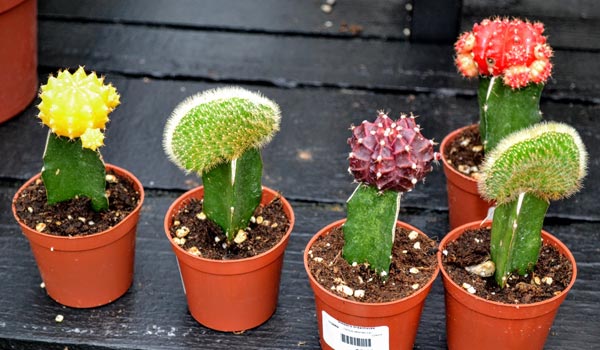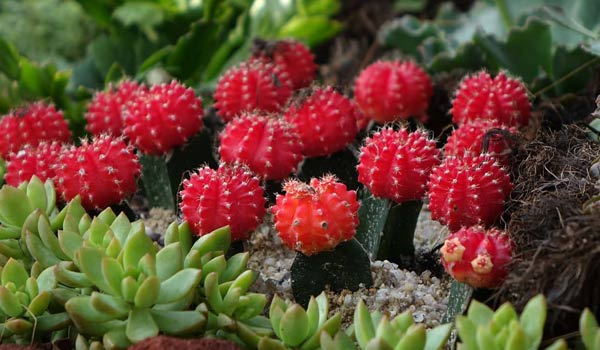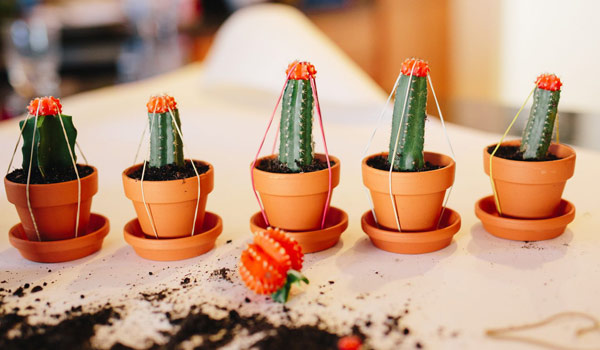Moon Cactus Care; How to Grow Moon Cactus

The moon cactus catches your eyes quickly in the crowded world of cacti and succulents. This 2-in-1 plant is a popular cactus for growing indoors. The moon cactus is distinguished by neon yellow, pink, orange, or red balls with thorns, sitting on top of a green-colored cactus.
For more information about this plant, moon cactus care, how to grow and always keep it happy and vibrant, read the following parts.

Moon Cactus, an Overview
Native to South America’s deserts, the moon cactus, or Gymnocalycium mihanovichii, has over 80 species and it is a member of the Cactaceae family. You may also know the plant by the name of ruby ball cactus, star flowered cactus, or simply red cap.
In the deserts of Brazil, Argentina, and Paraguay, this plant grows up to 1-2 inches wide with clusters of small, sharp spines and bright colors. This is a small plant, but there are cultivars that grow it up to 8 inches in diameter.
When looking at a cactus moon, you realize that it is grafted onto a rootstock. This is because as houseplants, itdoesn’t produce chlorophyll (hence its vivid colors). And without this matter, it can’t produce sugar through photosynthesis. Therefore, moon cactus grafting is necessary so it can survive.
Most of the time, moon cactus pups are grafted with dragon fruit cactus (Hylocereus undatus). Cereus peruvianus and Trichocereus spachianus are also common options. However, you can choose any green cactus species that you’d prefer for moon cactus grafting. What we’re looking for is essentially a cactus that can produce chlorophyll.

Moon Cactus Care
Unfortunately, even with the best care, the moon cactus lifespan is not very long. On average, this species lives between 1 to 3 years. But with the improper moon cactus care, it wouldn’t live more than a few months.
This is how you can extend your moon cactus lifespan:
How Often to Water Moon Cactus
This mutant cactus requires minimum water, and you don’t have to water it frequently (every 2 weeks would be fine). Even in its natural habitat, the cactus moon grows better without excess rainfall. So if growing outdoors, and it rains frequently where you live, we recommend growing your cactus under a covered porch.
By feeling the soil, you can tell how often to water moon cactus. For example, if the dirt is dry and dusty, mild watering would be a good idea. Be careful not to overwater this plant. Waterlogged and soggy soil causes root rots and other problems, and can even lead to moon cactus dying.
If your plant is one year old or older, we recommend not to water it during winter. But if your cactus moon plant is younger, it will appreciate a little bit of watering in the winter.
Light & Temperature
Gymnocalycium mihanovichii’s light and temperature requirements are similar to any other desert-type plant.
It grows best in bright but indirect sunlight, as long periods of direct sunlight can cause sunburns or other challenges for your plant. Anywhere that much of the direct sunlight is blocked, like a covered porch with some shade, can be the ideal location for your ruby ball cactus.
This plant can survive a winter freeze. But we don’t recommend living it outside when the temperature is below 40 °F. So for a longer moon cactus lifespan, it’s better to bring it indoors or in the garage. If that’s not an option, cover your plant using a sheet or light blanket so that it doesn’t freeze.
Soil & Fertilizer in Moon Cactus Care
To grow these cacti, you need to provide a potting soil mix that is actually ideal for the rootstock. The common bottom cacti usually prefer a well-draining soil mix with low pH levels and rich in organic matter.
It is not vital to fertilize moon cacti. However, they enjoy feeding during their growing season, which is from April to September. During this time, fertilize your plant with a cactus fertilizer every month. Don’t feed your cactus moon over the winter months.
Potting & Repotting
Warm seasons are the best time for repotting. Before transplanting, make sure that the potting soil is dried out completely. After taking the cactus out of the pot gently, remove the excess soil around it. Also, trim any rotten or dead roots, and treat using a fungicide.
Prepare an unglazed, shallow pot with drainage holes; add a thin layer of gravel in the bottom of it for better drainage, and fill fresh cactus potting mix. Finally, plant your cactus moon in the soil with its roots spread out.
Tip: Don’t water a recently repotted cactus for about a week to avoid root rot and moon cactus dying.
Cactus Moon Pests & Diseases
Root rot is a common problem among cacti that is the direct result of over-watering. However, there are other problems that can harm your beautiful plant. Pest won’t be the biggest concern, but the same doesn’t go for mealybugs or spider mites.
When you see signs of infestation, first, quarantine your moon cactus plant. Next, remove the insects with rubbing alcohol. To avoid the same problem in the future, you can use systemic pesticides or contact insecticides.

Moon Cactus Grafting
As mentioned, Gymnocalycium mihanovichii is a grafted cactus and can’t propagate. If the top of your cactus moon is separating from the rootstock, here’s how you can re-graft it:
- Sterilize a sharp knife, and carefully remove the colorful top.
- Next, trim the rootstock cactus, or cut off the old rootstock’s top layer if you don’t want to use a new one.
- Place the red cap on top of the rootstock, and secure it firmly with rubber bands. After about two weeks, the two cacti will be bonded, and you can remove the rubber bands.
After six to eight weeks, the plants will grow together as one star-flowered cactus.
Moon Cactus Propagation
There is something that you need to know before propagating this unique cactus with seeds: takes at least one year. So if you have the required passion and patience, these are the steps for moon cactus propagation:
- Place the seeds over a dry cactus mixture. Cover the seeds with a sprinkle of fine grit.
- Spray the soil (to simply moisten it), and place the container in a warm spot for germination.
- When the seedlings are large enough to remove, re-plant them in groups for best results.
These cacti with their vibrant tops, small dimensions, and easy care are truly irresistible. Get your own ruby ball cactus and complete your succulent collection. Just remember that it’s a grafted plant. So you pay attention to both parts for the longest moon cactus lifespan.
- In this post:
- Moon Cactus, an Overview
- Moon Cactus Care
- Moon Cactus Grafting
- Moon Cactus Propagation



